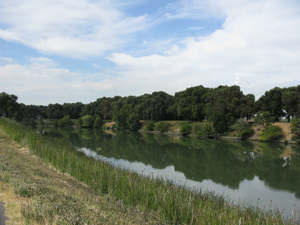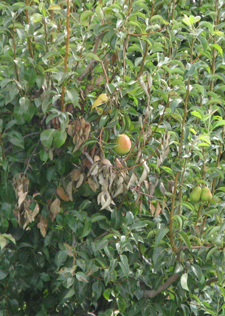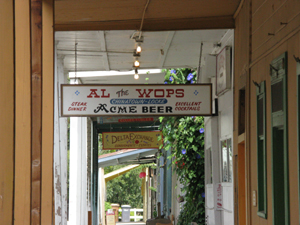The Sacramento River Delta area is a part of California unknown to most tourists and many residents. Water running
 Along the Delta
off mountain ranges like the Sierra Nevada, the Coast ranges and the southern part of the Cascades pours into the delta,
passes through an area of many mostly man-made islands and eventually finds its way to the ocean through the Golden Gate
bridge. The land areas are mostly agricultural, with rich peat soil,
protected by levees which make everybody nervous
because they have broken from time to time. We wanted to see the Delta scenery.
Along the Delta
off mountain ranges like the Sierra Nevada, the Coast ranges and the southern part of the Cascades pours into the delta,
passes through an area of many mostly man-made islands and eventually finds its way to the ocean through the Golden Gate
bridge. The land areas are mostly agricultural, with rich peat soil,
protected by levees which make everybody nervous
because they have broken from time to time. We wanted to see the Delta scenery.
We set out for the Sacramento River Delta on a hot morning with the air full of haze from the Los Angeles fires. Half
an hour east of home by freeway we turned north and detoured through the community of Mountain House, a development built
beginning in 2001 by one builder, with others following closely after. It was designed to be 15,600 homes, in 12 communities
each with its own style and focus (families with children, seniors, etc.), each community to have  J-Mack ferry dock
its own park. After the
crash of 2008, about 90% of home owners owed more than the home's value, according to the New York Times. As we drove around
we saw several of the communities, with attractive houses on very small lots. Almost every street had multiple "For Sale" signs
and neglected lawns, but the common grounds were being landscaped today, and the occupied houses were clearly well kept.
It will be interesting to see this area in a couple of years.
J-Mack ferry dock
its own park. After the
crash of 2008, about 90% of home owners owed more than the home's value, according to the New York Times. As we drove around
we saw several of the communities, with attractive houses on very small lots. Almost every street had multiple "For Sale" signs
and neglected lawns, but the common grounds were being landscaped today, and the occupied houses were clearly well kept.
It will be interesting to see this area in a couple of years.
We next drove north to the small city of Rio Vista, where we crossed the Sacramento River and began to wind our way up the
levee road. During this part of the drive we took two ferries, each making a crossing lasting less than five minutes. These
 Pears at Courtland
ferries, which are free, carried one or two cars per trip (although they had a capacity of six or eight). The schedule is basic: the boat will cross when a passenger arrives
at the dock, except for a 20-minute "lunch" break at 7 am and 7 pm.
Pears at Courtland
ferries, which are free, carried one or two cars per trip (although they had a capacity of six or eight). The schedule is basic: the boat will cross when a passenger arrives
at the dock, except for a 20-minute "lunch" break at 7 am and 7 pm.
The Old River Road passes through many pear orchards. We explored the tiny town of Courtlandt, the "pear capital of the universe"
(according to the Delta Chamber of Commerce flyer). It's a quiet and picturesque town of just a few hundred people, surrounded
by orchard upon orchard of pear trees filled with ripening fruit.
The Grand Island Mansion has 58 rooms and is popular for weddings and, they say, Sunday brunch. It was designed in 1917 for the
pear king, or orchardist, Louis Meyers, who wanted an impressive home in which to entertain his famous visitors (including
author Erle Stanley Gardiner) who would arrive by riverboat. It has recently been restored as a venue for private and corporate
parties -- after all, it is said to be the largest private home in northern California.
 The Grand Island Mansion
When we weren't crossing by ferry, we were traversing bridges. The favorite Delta bridge appears to be the bascule bridge, a
drawbridge controled by weights on each end. All of the bridges and roads are narrow, and the roads twist charmingly along the
river banks. The broad rivers, or "sloughs" seem peaceful; Houseboating on the Sacramento river is a popular summer family recreation
and we saw several houseboats of various shapes and sizes pulled up along the river's edge. This scenic two-lane road is,
however, hair-raising because much of the traffic is large trucks hauling produce.
The Grand Island Mansion
When we weren't crossing by ferry, we were traversing bridges. The favorite Delta bridge appears to be the bascule bridge, a
drawbridge controled by weights on each end. All of the bridges and roads are narrow, and the roads twist charmingly along the
river banks. The broad rivers, or "sloughs" seem peaceful; Houseboating on the Sacramento river is a popular summer family recreation
and we saw several houseboats of various shapes and sizes pulled up along the river's edge. This scenic two-lane road is,
however, hair-raising because much of the traffic is large trucks hauling produce.
Our major destination for this trip was Locke, California. The Gold Rush and the development of the transcontinental railroad,
 Locke, California
plus the engineering of levees on the islands of the delta had produced employment opportunities for many Chinese laborers who moved
here when their original employment ended. They built Chinatown areas in Locke and in neighboring Walnut Grove. When the Chinatown
section of the latter town burned down, Locke absorbed additional Chinese residents. Today, Locke is nearly a ghost town, but a most
picturesque one, with the original buildings and balconies and boardwalk of over a hundred years ago.
Locke, California
plus the engineering of levees on the islands of the delta had produced employment opportunities for many Chinese laborers who moved
here when their original employment ended. They built Chinatown areas in Locke and in neighboring Walnut Grove. When the Chinatown
section of the latter town burned down, Locke absorbed additional Chinese residents. Today, Locke is nearly a ghost town, but a most
picturesque one, with the original buildings and balconies and boardwalk of over a hundred years ago.
We stopped for lunch at Al The Wop's Cafe, an institution which was opened in the 1940's and has continued unabated ever since.
The original menu consisted of Big Steak and Little Steak but is currently broader, having added hamburgers, fried chicken and
grilled cheese sandwich. The walls hold old photographs, including quite a few photos of groups of people enjoying a meal together.
 Our restaurant sign
Diners sit on wooden benches at plain, well-worn tables. Of course we ordered Steak Sandwich, which came with grilled bread and a
salad of lettuce with Thousand Island dressing (the salads are all made up and ready to go; we watched a woman come in, pick up her
salad and head back out the door; later she came in for her main plate, which she also took outside, presumably to her shop or home).
On each table, in addition to the usual condiments, were jars of Jif peanut butter and marmalade along with spreading knives.
We also shared an order of Stinky Fries, French fries with, we think, grated cheese and garlic.
Our restaurant sign
Diners sit on wooden benches at plain, well-worn tables. Of course we ordered Steak Sandwich, which came with grilled bread and a
salad of lettuce with Thousand Island dressing (the salads are all made up and ready to go; we watched a woman come in, pick up her
salad and head back out the door; later she came in for her main plate, which she also took outside, presumably to her shop or home).
On each table, in addition to the usual condiments, were jars of Jif peanut butter and marmalade along with spreading knives.
We also shared an order of Stinky Fries, French fries with, we think, grated cheese and garlic.
There were few cars in the many parking lots giving access to Historic Walnut Grove, for the reason that there is not much to see. Many of the "sights" are actually "sites" of buildings destroyed in the fire. We viewed the stately facade of the Bank of Alex Brown of Walnut Grove, which we subsequently determined has no relationship to the earlier Bank of Alex Brown of Baltimore (from which descended Deutsche Bank Alex Brown and Brown Brothers Harriman).
 A waterfront mansion
A waterfront mansion
On the way to lunch we had noted several homes along the river which seemed like large and elegant mansions, in curious juxtaposition
to the modest frame houses, auto body repair shops and mobile home parks common in the region. We returned after lunch and reconnoitered. One mansion had a sign dating it to 1935, when we would guess they were all built. Were they built as vacation homes, or did they belong to prosperous local farm owners?
The Sacramento Delta was a pleasant day trip from the Bay Area. Some of the small towns seem to be solidly planted in the mid-twentieth century, and the scenery along the levees is quite attractive. We continue to believe that California has more scenic variety than any other state.
 Along the Delta
off mountain ranges like the Sierra Nevada, the Coast ranges and the southern part of the Cascades pours into the delta,
passes through an area of many mostly man-made islands and eventually finds its way to the ocean through the Golden Gate
bridge. The land areas are mostly agricultural, with rich peat soil,
protected by levees which make everybody nervous
because they have broken from time to time. We wanted to see the Delta scenery.
Along the Delta
off mountain ranges like the Sierra Nevada, the Coast ranges and the southern part of the Cascades pours into the delta,
passes through an area of many mostly man-made islands and eventually finds its way to the ocean through the Golden Gate
bridge. The land areas are mostly agricultural, with rich peat soil,
protected by levees which make everybody nervous
because they have broken from time to time. We wanted to see the Delta scenery.
 J-Mack ferry dock
J-Mack ferry dock Pears at Courtland
Pears at Courtland The Grand Island Mansion
The Grand Island Mansion Locke, California
Locke, California Our restaurant sign
Our restaurant sign A waterfront mansion
A waterfront mansion